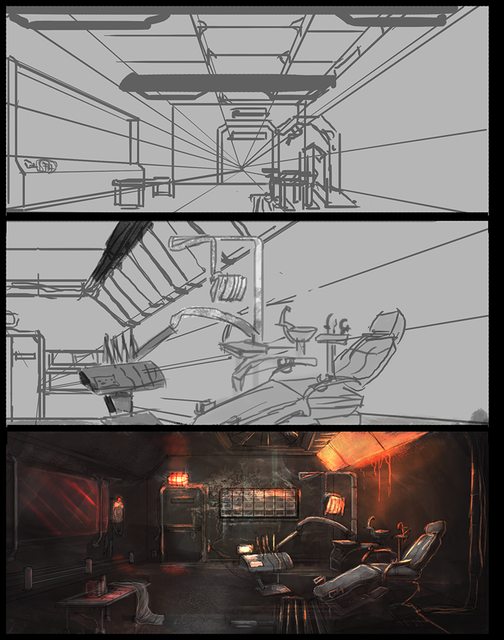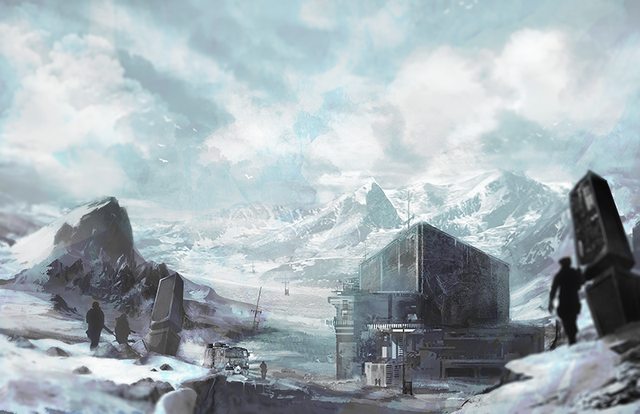Everything you read here can also be found on our website: Gurugames.se
So, this week I am in charge of the Devblog, so firstly let me introduce myself! My name is Louise Meijer and I am a 2D-artist at Guru Games, where I make environment and character-concepts, promotion art, and also textures for 3D-models to our game Magnetic. What I´d really like to do is a horse-game, but that idea didn´t fly with the rest of the team, so….horror and metal it is!
I´ve spent the last 10 weeks away from the team, doing an internship at another company, and came back this week, so there´s been a lot of catching up to do. A lot had changed in Magnetic in just 10 weeks but the best part of it, from my point of view as a concept artist, was the fact that the designers had created a wiki-page for the game. On the wiki-page they had gathered all kind of information concerning the game that is of interest from a creative point of view, they explained the setting, what time period the game is supposed to take place in (which before had been quite unclear) and in general described the entire world the game takes place in. Rather than just having a game with rooms and levels to clear, they had built a world around the story, making the concepting of new environments, props and characters a lot more fun and easy! Early on we’d work mostly with moodboards and stylesheets, collages of pictures that defined what the final result should look like, but the addition of information on the wikipage with history and technical specifications of the facility where the game takes place eased the challenge to keep everybody working towards the same goal.
Art is always a great way to keep a team on the same visual level, but the process of making concepts and what details to add is greatly improved when given boundaries to work from. Presenting a much more evaluated picture of the game than before made it a lot easier to create settings focused on certain time periods and achieving the look of a facility that has developed over time. For example, before when creating a room and realizing it needed a chair, I would just paint a generic type of chair, but now I know what time period to research, to look into fashion and popular styles of the time, making the environment much more unique and alive then before.

(Some work process of a nasty room (had to be a dentists chair!)
Of course this burst of information and newly found inspiration propose a problem, the fact that you get stuck painting something that will never actually be seen by a player in the game, such as the concept below, which illustrates the outside of the facility. Art like this is so much fun to create and as an artist it's easy to get sucked in to all the “fun” art rather than creating actually useful art. Of course this type of art still serves a purpose as inspiration for the team yet it´s important not to get stuck working on things that aren´t even planned on being seen in the game. As a concept artist you often creating things never seen by players, environments that gets cut due to time estimates, characters which will never be created, so working with clear directives and the oh so joyful “Kill your Darlings!” attitude (which basically means don´t get attached to your art or ideas, cause they will be altered, so deal with it) is a mandatory necessity as a concept artist.

The basics of concept art is the fact that it needs to be finished yesterday, always….the faster the concepts are done the sooner the 3Dartists can create placeholders to implement into the game engine, giving the designers puzzle pieces to work with when creating challenges for the player and so on.
So, speed is key!
To help speed up the process custom brushes are highly recommended. Either making your own or using free ones made by other artists can speed up your work process tremendously. Many of the best concept artists in the business give their brushes away since they themselves uses brushes they don´t know the origin of. Sharing is caring and the digital community shares a lot, so don´t be afraid to use the tools provided. One talented concept artist is Daarken whose brushes can be found and downloaded on his homepage Enliighten.com under tutorial and my brushes. Go and check them out, the world needs more awesome art!
So, this week’s update was again made by a 2D Artist at Guru Games, so maybe it´s time to let another discipline have a go at it? If you have any suggestions, feel free to let us know in the comments section below, or on Facebook, Twitter or Google+!



Your art looks amazing Louise. I really hope you get to make your horse game next ;)
Thank you!! A bit rusty with environments, but gonna get some practice now! and YES!*_* needs.more.horse.games.